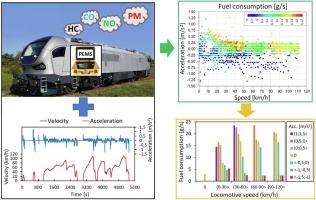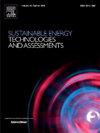Real-world assessment of the energy consumption and emissions performance of a novel diesel-electric dual-drive locomotive
IF 7.1
2区 工程技术
Q1 ENERGY & FUELS
Sustainable Energy Technologies and Assessments
Pub Date : 2024-10-04
DOI:10.1016/j.seta.2024.104017
引用次数: 0
Abstract
The huge demands for better energy efficiency and cleaner air from the public have driven governments to implement increasingly stricter emission standards. However, their implementation was not conducted uniformly among transport sectors. While road vehicles are now tested both in laboratory and real-world, rail vehicles are still only required to be tested in stationary conditions that have been shown to poorly reflect their real operation conditions. Therefore, this study aimed to assess the performance of a novel diesel-electric dual-drive locomotive in real-driving conditions. Significant variations were found for the tested locomotive in terms of both the share of idling time and the share of time the engine operated beyond the type-approval tests. The tested locomotive spent a similar share of time idling (24 %) as at its intended speed (60–90 km/h). It was found that 37 % of the particulate matter emissions were released during stops. Reducing the amount of time when the vehicle was accelerating at more than 0.5 m/s2, especially at speeds over 60 km/h, could reduce 50 % carbon monoxide emissions and 40 % hydrocarbon emissions. The findings suggest that incorporating the practice of eco-driving should be considered to significantly reduce the pollutant emissions from the railway sector.

新型柴油-电力双驱动机车能耗和排放性能的实际评估
公众对更高能效和更清洁空气的巨大需求促使各国政府实施越来越严格的排放标准。然而,这些标准在各运输部门的执行情况并不一致。目前,公路车辆既要进行实验室测试,也要进行实际测试,而铁路车辆仍然只需在静止条件下进行测试,这已被证明不能很好地反映车辆的实际运行状况。因此,本研究旨在评估新型柴油-电力双驱动机车在实际驾驶条件下的性能。测试机车的怠速时间比例和发动机运行时间比例均超出了型式批准测试的要求,这两方面均存在显著差异。测试机车的怠速时间比例(24%)与预定速度(60-90 km/h)相近。结果发现,37% 的颗粒物排放是在停车时释放的。减少车辆加速超过 0.5 米/秒2 的时间,尤其是时速超过 60 公里时,可以减少 50% 的一氧化碳排放和 40% 的碳氢化合物排放。研究结果表明,应考虑采用生态驾驶的做法,以大幅减少铁路部门的污染物排放。
本文章由计算机程序翻译,如有差异,请以英文原文为准。
求助全文
约1分钟内获得全文
求助全文
来源期刊

Sustainable Energy Technologies and Assessments
Energy-Renewable Energy, Sustainability and the Environment
CiteScore
12.70
自引率
12.50%
发文量
1091
期刊介绍:
Encouraging a transition to a sustainable energy future is imperative for our world. Technologies that enable this shift in various sectors like transportation, heating, and power systems are of utmost importance. Sustainable Energy Technologies and Assessments welcomes papers focusing on a range of aspects and levels of technological advancements in energy generation and utilization. The aim is to reduce the negative environmental impact associated with energy production and consumption, spanning from laboratory experiments to real-world applications in the commercial sector.
 求助内容:
求助内容: 应助结果提醒方式:
应助结果提醒方式:


